Cacio e pepe is a classic pasta dish from Italy’s capital city of Rome and its surrounding villages in the Lazio region.
Literally translated, “cacio e pepe” means “[pasta with] cheese and pepper” in Italian. As the name suggests, cacio e pepe is a dish made of pasta noodles, grated cheese, and black pepper.
The pasta varieties that Romans typically use for making cacio e pepe are tonnarelli, also known as “spaghetti alla chitarra,” or spaghetti. I’ve also had success making this pasta dish with bucatini (thick spaghetti with a hole in it), tagliatelle, and fettuccine.
What’s the best cheese to use for cacio e pepe? In general, any hard Italian cheese variety that’s been aged for 9-12 months will do great.
The traditional cheese for cacio e pepe is Pecorino Romano, a hard, salty, and sharp Italian cheese made with sheep’s milk. If Pecorino Romano is not readily available to you, you can substitute it for Grana Padano or Parmigiano-Reggiano.
While Pecorino Romano, Grana Padano, and Parmigiano-Reggiano are the staple cheeses for this recipe, you could just as well use other Pecorino varieties (like Pecorino Siciliano, Pecorino Toscano, Pecorino Sardo), Asiago Stravecchio, Manchego, or Bitto.
Don’t use pre-grated cheese. Cheese is the star of this Roman dish. Most of the pre-grated cheeses that they sell in grocery stores are subpar in quality, which means your pasta won’t come out as aromatic and flavorful as you want it.
How to Make Authentic Cacio e Pepe Like a Roman
The correct technique for making cacio e pepe is to boil the pasta in a pot while you’re making the cheese and pepper sauce in your pan.
Mastering this technique—and the timing that comes with it—is the secret to learning how to prepare this classic Roman pasta dish like a local.
I’m not Roman, but I’m about to share everything that I’ve learned from watching Italian chefs from the Lazio region cook it (and replicating their technique in my home kitchen).
Bring a pot of generously-salted water to a rolling boil. As the saying among Italian pasta chefs goes, “pasta water should taste like the sea.”
Add the pasta noodles to the boiling water. Let them cook, stirring occasionally, until the noodles are almost al dente. You will usually achieve this by cooking the pasta 2-3 minutes less than the recommended cooking time in the instructions on the package.
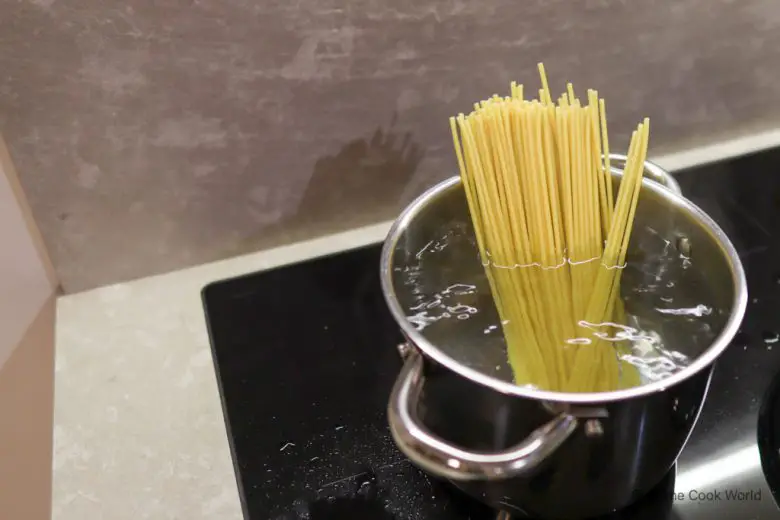
“Al dente” is an Italian term that describes the state of perfectly cooked pasta. Al dente noodles are tender and cooked through on the inside, but still firm to the bite and with a very slight crunch on the outside.
While the pasta boils in the pot, finely grate a 6 oz wedge of Pecorino Romano, Grana Padano, or Pecorino-Romano cheese in a small bowl. You need the equivalent of 1 U.S. cup of cheese for cacio e pepe. You could also make a mix of hard Italian cheeses if you like.
Scoop out 1/2 ladle of salty and starchy pasta water from the boiling pot of pasta (that’s roughly 11-13 tablespoons) and pour it into the bowl of finely-grated cheese. The trick is to use not too much pasta water, as the sauce will get watery. Yet not too little, as it will get clumpy. If you see yours going off in either direction, add a bit more cheese or, conversely, a bit more water.
Using a whisk, mix the cheese and pasta water together until they’ve turned into a uniform-enough pasta sauce.
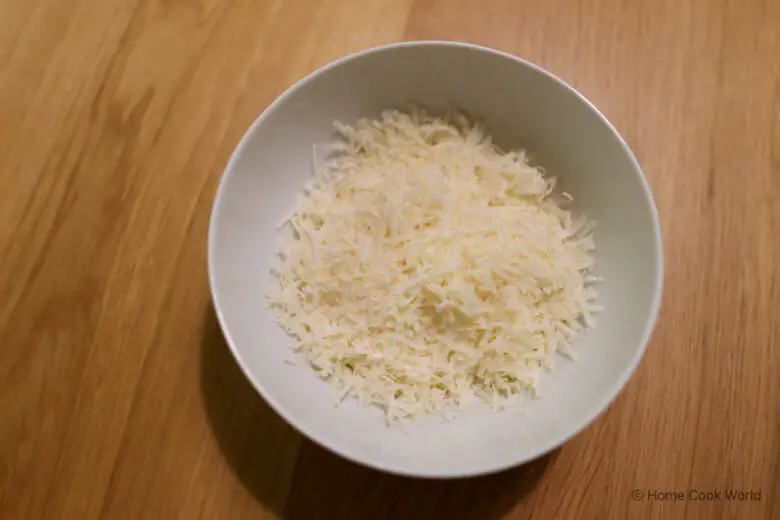
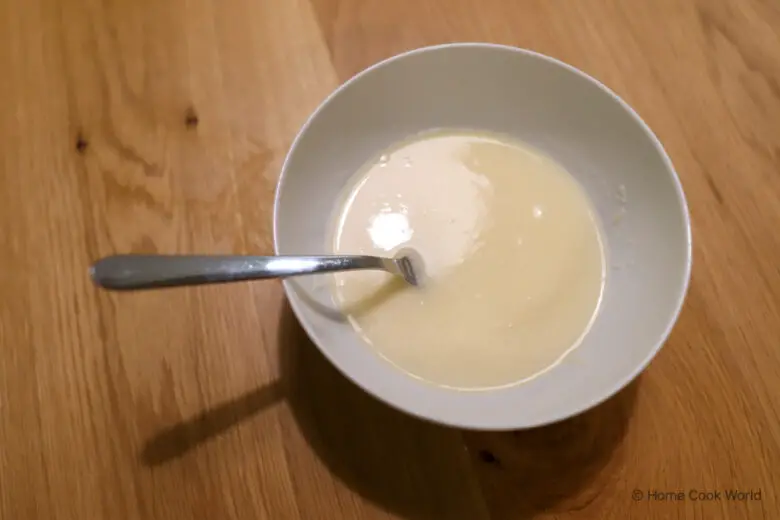
Set the bowl aside. The pasta noodles are almost done. As you’re waiting for them to come out almost al dente, proceed to the second part of making the cacio e pepe sauce.
Put your frying pan on the cooktop, set the heat to medium-high, and crack a hefty amount of black peppercorn in the pan using a pepper mill.
Spices add flavor to your food thanks to the essential oils that they contain. In the case of black peppercorn, the flavor is encapsulated inside the tough outer layer of skin. Cracking, crushing, or grinding the peppercorns releases it.
How much black pepper to add to your cacio e pepe pasta depends on how hot you like your food. I like mine really, really hot, which is why I normally end up cracking about a handful of black pepper (0.2 oz) in my pan.
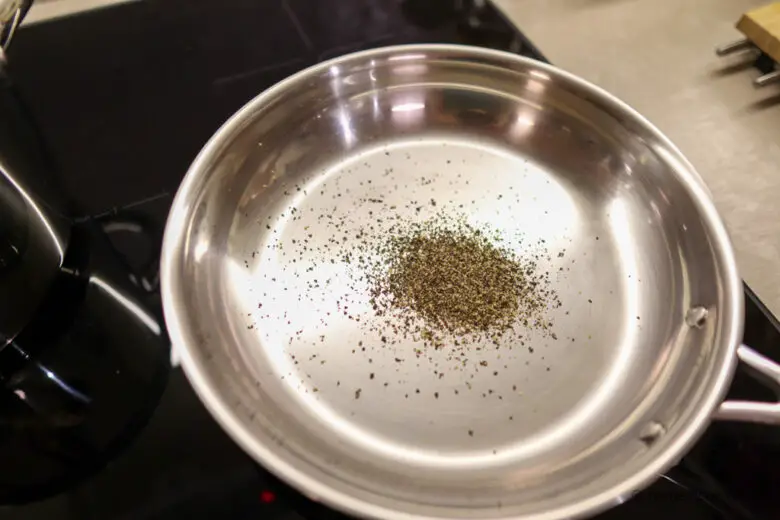
The first time you make this pasta dish, you’ll probably want to go easy on the black pepper. You can always crack a little more of it on top of your pasta after it’s done. But you can’t salvage it if it comes out too pungent for your taste.
Heat the freshly-cracked black pepper in your pan for 30 seconds, until you can feel its piquant bite and potent smell in the air of your kitchen.
Pepper burns easily. When that happens, it starts to taste bitter. So don’t heat the pepper for too long or, otherwise, its excessive bitterness will ruin the overall taste of your dish.
You’re going to use the same technique with the pasta water again. Transfer ½ soup ladle of pasta water from the pot to your pan, “drowning” the black pepper in it.
Have your range hood turned on (and set to the highest setting) when you mix the pasta water with the black pepper in your pan.
The pasta water will immediately blend with the black pepper and start to evaporate as soon as it comes into contact with the scorching-hot surface of your pan.
The peppery vapor will almost certainly bring tears to your eyes. Having it sucked out of the air in your kitchen as soon as possible will definitely feel like a relief.
As you get close to the end of this recipe, bring down the heat to low and give your pan 15-20 seconds to cool down. If your pan is too hot when you sauce the pasta with the cheese, the proteins in the cheese will clump.
Mixing the cheese sauce with your pasta is a second moment to watch out for. When heated, proteins get tougher (this is what happens when you’re soft-boiling vs. hard-boiling an egg). A pan that’s too hot can curdle the cheese, giving your sauce a weird texture. When in doubt, cooler is definitely better.
It’s time to combine the pasta noodles, cheese sauce, and pepper sauce altogether.

Use a pasta fork to transfer the noodles from your pot to your pan. There’s no need to strain the noodles; you will cook down the sauce as you finish the dish off on the cooktop.
Pour the cheese sauce that you had set aside from the bowl into your pan. Stir, combining the sauce and pasta well. You want the sauce to coat the surface of the noodles as much as possible, adding aroma and flavor to each and every one of them.
Finish cooking the pasta noodles with the sauce, stirring and tossing often, as the cacio e pepe sauce thickens. After 60 seconds, your dish should be done and ready to serve.
Plate the pasta. Optionally (and for a final touch), grate some more Pecorino Romano cheese on it, and crack a little more black pepper on top.




The Recipe
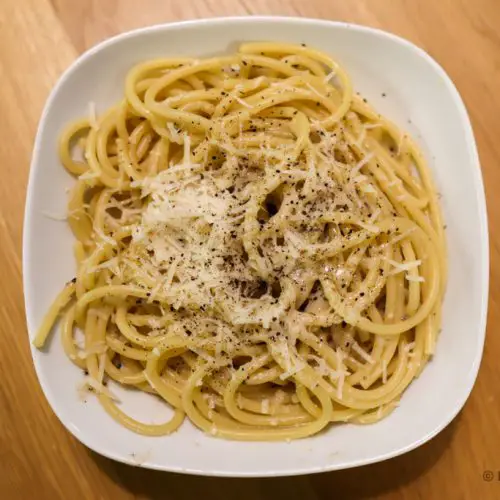
Cacio e Pepe
Equipment
- Pasta pot
- Pasta fork
- Frying pan
- Cheese grater
Ingredients
- 1 U.S. cups long pasta noodles (spaghetti, spaghettoni, or bucatini)
- 1 pinches salt (Mediterranean sea salt)
- 6 oz hard Italian cheese (Pecorino Romano, Grana Padano, and/or Parmigiano-Reggiano)
- 0.2 oz black pepper
Instructions
Boil the pasta
- Bring a generously salted pot of water to a rolling boil.
- Add the pasta to the pot. Cook the noodles, stirring occasionally, for 2-3 minutes less than the recommended cooking time in the instructions on the package.
Make the cacio e pepe sauce
- Finely grate a wedge of hard Italian cheese in a bowl.
- Add ½ soup ladle of pasta water to the bowl and mix it together with the finely-grated cheese, using a fork or whisk, until it becomes uniform. Set aside.
- On your cooktop, preheat a frying pan on medium-high heat for 2-3 minutes.
- Crack a hefty amount of black peppercorn in the hot pan. Let the freshly-cracked black pepper heat for 30 seconds, until you can smell its pungency in the air.
- Add ½ soup ladle of pasta water to the frying pan, drowning the black pepper in it.
Toss the pasta with the cacio e pepe sauce
- Bring down the heat to low. If your pan is too hot as you pour the cheese sauce, the proteins in the cheese will clump. Allow your pan 15-20 seconds to cool down.
- Transfer the pasta noodles to the pan and pour the cheese sauce from the bowl on it. Stir and toss to incorporate the ingredients.
- Cook the pasta in the sauce, stirring and tossing often, for 60-90 seconds.
- Plate the pasta. Grate some more hard Italian cheese on it, crack a little more black pepper on top of it, and serve.
Nutrition
Should I Use Fresh or Boxed Pasta for Cacio e Pepe?
You can make cacio e pepe with fresh pasta or boxed pasta. As long as you know how to make the most of each of these two different kinds of pasta, your dish will come out tasting just as good.
Boxed pasta, the kind that’s made by the best pasta brands and carried by virtually every grocery store, is made of semolina flour and water. It’s dried to a moisture content of 12.5% before being packaged, which gives it a really long shelf life (2-3 years), as well as a firm texture and rough surface. If you like your pasta noodles al dente (firm to the bite and slightly crunchy on the outside), boxed pasta is the best kind to use.
Fresh pasta is made with flour, water, and eggs. With a moisture content of 30%, fresh pasta has a delicate texture and cooks for roughly half the time of boxed pasta. The drawback is that it’s a highly perishable food with a short shelf life (2-3 days). If you like your pasta noodles tender and slightly chewy, fresh pasta is the right choice for you.
Is Caccio e Pepe Made With Olive Oil or Butter?
There’s no olive oil or butter in the traditional preparation of cacio e pepe. The only ingredients are pasta, salt for the pasta water, grated Pecorino Romano cheese, and freshly-cracked black pepper.
Some YouTube chefs and food bloggers will tell you to add olive oil or butter to your cacio e pepe pasta. Don’t listen to them. The heartiness of this dish comes from the creamy and sharp sauce made of grated Pecorino Romano cheese mixed with the starchy and salty pasta water.
Adding olive oil or butter to your cacio e pepe will overwhelm its aroma and flavor with an ingredient that’s not really supposed to be there in the first place.
Cacio e Pepe vs. Carbonara
Both cacio e pepe and carbonara are Roman pasta dishes with black pepper as a key ingredient. Cacio e pepe is made with pasta, salt, Pecorino Romano cheese, and black pepper. Carbonara, on the other hand, is made with pasta, salt, Pecorino Romano cheese, eggs, Guanciale, and black pepper.
As with other Italian dishes that date back a long time, it’s impossible to determine which of the two came first. Cacio e pepe and carbonara are made using the same technique of cooking up a pasta sauce with pasta water and a few simple ingredients.
It’s reasonable to assume that Romans made cacio e pepe whenever they didn’t have Guanciale (cured pork jowls) and eggs available.
In “Antonio Carluccio’s Spaghetti Carbonara Recipe,” I show you the best way for making pasta alla carbonara by breaking down the cooking techniques of the late Antonio Carluccio, without doubt one of the most amiable Italian chefs of all time.
Cacio e Pepe vs. Alfredo
Pasta Alfredo is an Italian pasta dish usually made with fettuccine tossed with butter and Parmigiano-Reggiano cheese. Pasta cacio e pepe is traditionally made with spaghetti tossed with a sauce of Pecorino Romano cheese, black pepper, and pasta water.
Though both of these hearty pasta dishes come from classic Italian cuisine, they’re made using very different cooking techniques. One relies on the fattiness of the butter to make a creamy sauce, the other on the starchiness of the pasta water mixed with the grated cheese.
In Conclusion
How did your cacio e pepe pasta turn out? Now that you’ve seen my technique for making it, do you have any others of your own that you’d like to share? Let me—and the rest of this post’s readers—know in the comments section below.

